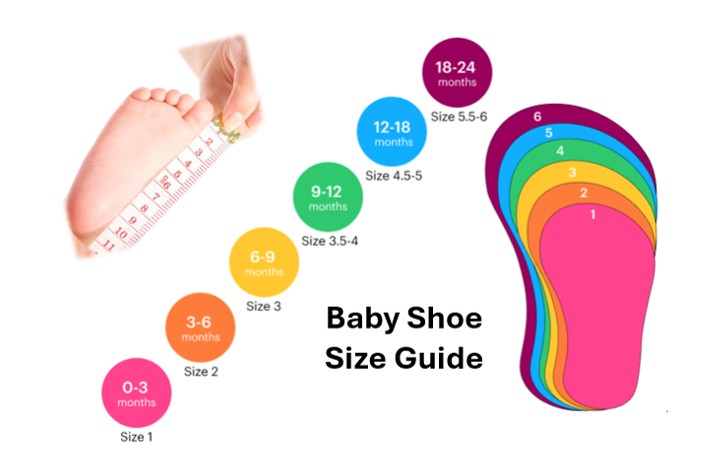Baby Shoe Size Chart
| Length (inches) | Length (inches) | Length (CM) | US Size | UK Size | Euro Size | JPN Size |
|---|---|---|---|---|---|---|
| 3 1/8" | 3.125" | 7.9 cm | 0 | 0 | 15 | |
| 3 1/4" | 3.25" | 8.3 cm | 0.5 | 0 | 16 | |
| 3 1/2" | 3.5" | 8.9 cm | 1 | 0.5 | 16 | |
| 3 5/8" | 3.625" | 9.2 cm | 1.5 | 1 | 17 | |
| 3 3/4" | 3.75" | 9.5 cm | 2 | 1 | 17 | |
| 4" | 4" | 10.2 cm | 2.5 | 1.5 | 18 | |
| 4 1/8" | 4.125" | 10.5 cm | 3 | 2 | 18 | 12 |
| 4 1/4" | 4.25" | 10.8 cm | 3.5 | 2.5 | 19 | 12 / 12.5 |
| 4 1/2" | 4.5" | 11.4 cm | 4 | 3 | 19 | 12.5 |
| 4 5/8" | 4.625" | 11.7 cm | 4.5 | 3.5 | 20 | 12.5 / 13 |
| 4 3/4" | 4.75" | 12.1 cm | 5 | 4 | 20 | 13 |
| Baby Shoe Size Chart Maker : iSizeChart.com | ||||||
About Baby & Toddler Shoe Size Guide Chart
How to choose a suitable baby shoe ?
Choosing the right baby shoes is essential for your little one's comfort, foot development, and safety.Here is a step-by-step guide :
1. Consider the Baby's Age & Stage.
Crawlers (6-12 months): Flexible, lightweight shoes with soft soles help with balance and exploration.
Early Walkers (12-18 months+): Choose shoes with flexible, non-slip soles and good ankle support.
2. Focus on the Right Fit.
Leave Room for Growth: About ½ inch (1.25 cm) of space between the longest toe and shoe tip.
Check Width: Avoid tight shoes; toes should wiggle freely.
3. Choose the Right Material.
Soft & Flexible: The shoe should bend easily at the toe.
4. Look for Key Features.
Adjustable Closures: Velcro or elastic straps make putting on/taking off easier.
Lightweight Design: Heavy shoes can make walking harder.
Ankle Support: Helps with stability for new walkers.
5. Avoid Common Mistakes.
Avoid Hard Soles: They restrict natural foot movement.
Skip Fashion-Only Shoes: Prioritize function over style.
6. When to Buy New Shoes.
If the heel slips out easily.
If the sole is worn out.
